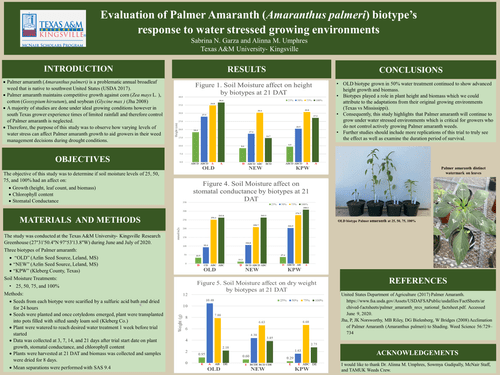Palmer amaranth is a vigorous competitor against crops due to its rapid growth rates and environment adaptations. In south Texas, producers experience periods of limited rainfall where most crops are grown under dryland growing conditions. Limited data is available on studying the effects of water stress on Palmer amaranth growth and development. Therefore, the scope of this study was to evaluate four soil moisture levels (25, 50, 75, and 100% moisture) and the response of three Palmer amaranth biotypes on (1) growth (height, leaf count, and weight), (2) chlorophyll content, and (3) stomatal conductance. The three biotypes used in the study were two from Leland, Mississippi (NEW and OLD) and one collected locally in Kingsville, Texas (KPW). Plants were grown in a sifted sandy loam soil and soil moisture was recorded and maintained daily. Data was collected at 1, 3, 7, 14, and 21 days after treatment (DAT) on plant growth and development. At 21 DAT after data was collected, plants were harvest, weighed, and dried for 8 days and biomass was calculated. Results showed that after 21 DAT, Palmer amaranth plants continued to grow considerably at the 50% soil moisture treatment. In addition, KPW biotype was recorded with the highest rate of stomatal conductance, likely due to it being adapted to south Texas growing conditions. Unfortunately, this study demonstrated that Palmer amaranth will continue to grow under water stressed environments. This information is vital to growers so that they may make cautious weed management decisions during times of drought-like conditions in order to reduce loss of crop yields.
Faculty Mentor: Dr. Alinna Umphres
Department of Agriculture, Agribusiness, and Environmental Sciences


